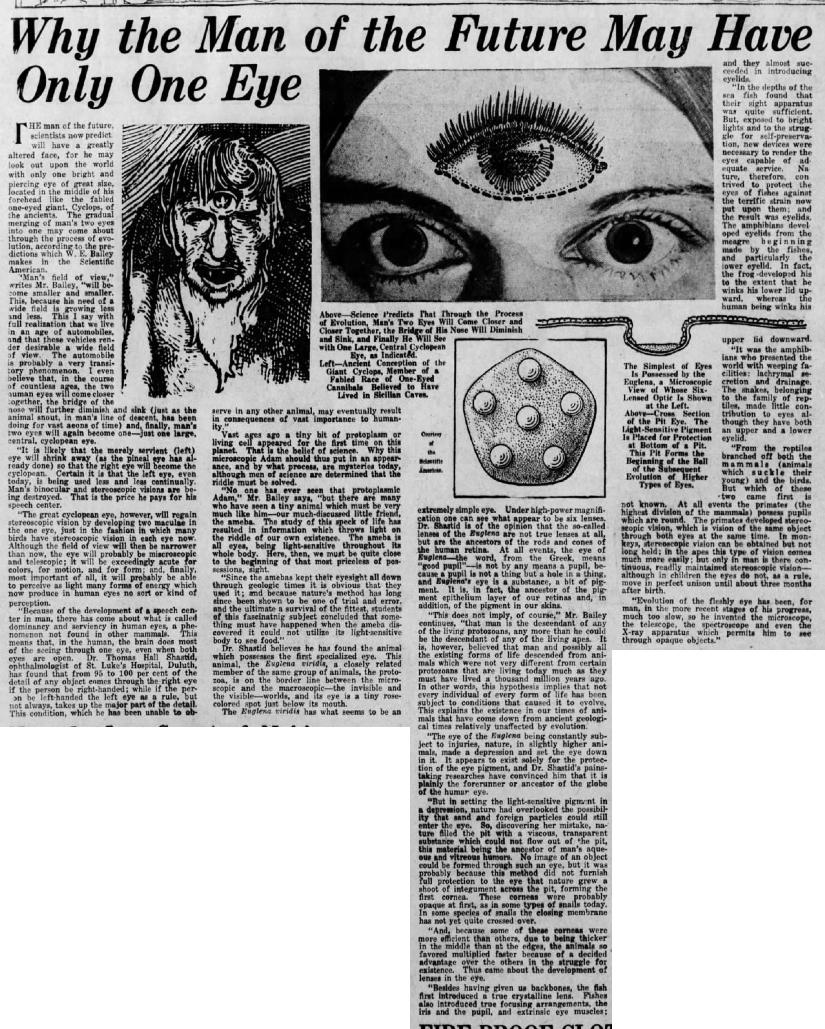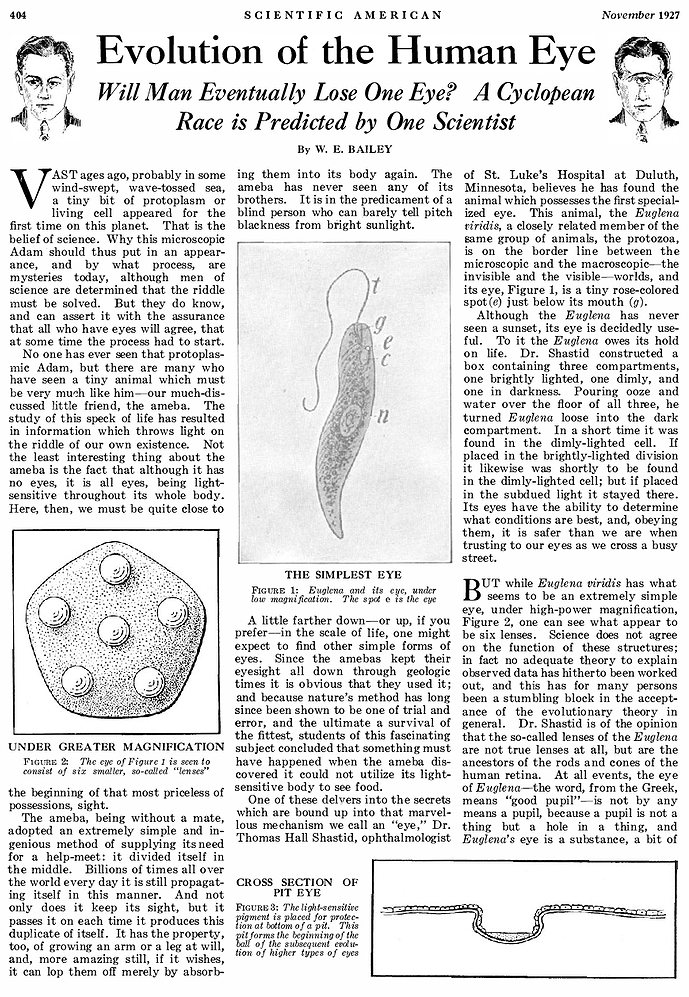Why the man of the future may have only one eye
1927: Scientist W.E. Bailey predicted that, in the far future, our descendants may have only "one large, central, cyclopean eye".
Of course, who knows what humans may look like in a million years (if there are even any of us still around), but his argument sounds plausible enough to me (with my limited knowledge of neuroscience). Basically he argued that, over the past several million years, our brains have devoted more space to speech, and less to vision. Extrapolating that trend into the future, he concluded that the eventual merging of our eyes into one would be a more efficient use of the brain's resources, and so will probably happen.


Of course, who knows what humans may look like in a million years (if there are even any of us still around), but his argument sounds plausible enough to me (with my limited knowledge of neuroscience). Basically he argued that, over the past several million years, our brains have devoted more space to speech, and less to vision. Extrapolating that trend into the future, he concluded that the eventual merging of our eyes into one would be a more efficient use of the brain's resources, and so will probably happen.

Minneapolis Star Tribune - Dec 4, 1927
The gradual merging of man's two eyes into one may come about through the process of evolution, according to the predictions which W.E. Bailey makes in the Scientific American.
"Man's field of view," writes Mr. Bailey, "will become smaller and smaller. This, because his need of a wide field is growing less and less. This I say with full realization that we live in an age of automobiles, and that these vehicles render desirable a wide field of view. The automobile is probably a very transitory phenomenon. I even believe that, in the course of countless ages, the two human eyes will come closer together, the bridge of the nose will further diminish and sink (just as the animal snout, in man's line of descent, has been doing for vast aeons of time) and, finally, man's two eyes will again become one—just one large, central, cyclopean eye.
"It is likely that the merely servient (left) eye will shrink away (as the pineal eye has already done) so that the right eye will become the cyclopean. Certain it is that the left eye, even today, is being used less and less continually. Man's binocular and stereoscopic visions are being destroyed. That is the price he pays for his speech center.
"The great cyclopean eye, however, will regain stereoscopic vision by developing two maculae in the one eye, just in the fashion in which many birds have stereoscopic vision in each eye now. Although the field of view will then be narrower than now, the eye will probably be microscopic and telescopic; it will be exceedingly acute for colors, for motion, and for form; and finally, most important of all, it will probably be able to perceive as light many forms of energy which now produce in human eyes no sort or kind of perception.
"Because of the development of a speech center in man, there has come about what is called dominancy and serviency in human eyes, a phenomenon not found in other mammals. This means that, in the human, the brain does most of the seeing through one eye, even when both eyes are open. Dr. Thomas Hall Shastid, ophthalmologist of St. Luke's Hospital, Duluth, has found that from 95 to 100 per cent of the detail of any object comes through the right eye if the person be right-handed; while if the person be left-handed the left eye as a rule, but not always, takes up the major part of the detail. This condition, which he has been unable to observe in any other animal, may eventually result in consequences of vast importance to humanity."
"Man's field of view," writes Mr. Bailey, "will become smaller and smaller. This, because his need of a wide field is growing less and less. This I say with full realization that we live in an age of automobiles, and that these vehicles render desirable a wide field of view. The automobile is probably a very transitory phenomenon. I even believe that, in the course of countless ages, the two human eyes will come closer together, the bridge of the nose will further diminish and sink (just as the animal snout, in man's line of descent, has been doing for vast aeons of time) and, finally, man's two eyes will again become one—just one large, central, cyclopean eye.
"It is likely that the merely servient (left) eye will shrink away (as the pineal eye has already done) so that the right eye will become the cyclopean. Certain it is that the left eye, even today, is being used less and less continually. Man's binocular and stereoscopic visions are being destroyed. That is the price he pays for his speech center.
"The great cyclopean eye, however, will regain stereoscopic vision by developing two maculae in the one eye, just in the fashion in which many birds have stereoscopic vision in each eye now. Although the field of view will then be narrower than now, the eye will probably be microscopic and telescopic; it will be exceedingly acute for colors, for motion, and for form; and finally, most important of all, it will probably be able to perceive as light many forms of energy which now produce in human eyes no sort or kind of perception.
"Because of the development of a speech center in man, there has come about what is called dominancy and serviency in human eyes, a phenomenon not found in other mammals. This means that, in the human, the brain does most of the seeing through one eye, even when both eyes are open. Dr. Thomas Hall Shastid, ophthalmologist of St. Luke's Hospital, Duluth, has found that from 95 to 100 per cent of the detail of any object comes through the right eye if the person be right-handed; while if the person be left-handed the left eye as a rule, but not always, takes up the major part of the detail. This condition, which he has been unable to observe in any other animal, may eventually result in consequences of vast importance to humanity."

Comments
And then, once there is one last man with only eye, he will create the evil Daleks to carry on his work.
Posted by KDP on 04/17/21 at 02:23 PM
His argument is bunk.
One, physiology doesn't work that way.
Two, we need two eyes to judge distance and his suggestion of "two maculae" is hogwash, so evolution doesn't work that way, either.
One, physiology doesn't work that way.
Two, we need two eyes to judge distance and his suggestion of "two maculae" is hogwash, so evolution doesn't work that way, either.
Posted by Richard Bos on 04/24/21 at 08:11 AM
Richard, you overstate the need of binocular vision for judging distance. There are many cues that the brain uses for judging distance, including perspective and texture. My father-in-law lost the vision in one eye as a child, yet he played tennis. Of course, the idea that humans will evolve into cyclopses is nonsense.
Posted by ges on 04/24/21 at 09:17 PM
Was Leela from Futurama based on this prediction?
Posted by the sleep commenter on 04/25/21 at 01:35 AM
In Futurama, toxic waste disposal consisted of dumping it in the sewer. The mix of chemicals caused human mutations. Leela was the child of two such mutants. Wanting a better life for her, they left her as a baby at a Minimum-Security Orphanarium with a note that made it seem like she was an alien (aliens were accepted into society, mutants weren't). She always believed herself to be the last of her race and didn't learn the truth until the fourth season.
Posted by Phideaux on 04/25/21 at 03:32 AM
Commenting is not available in this channel entry.

Category: Science | Anthropology | 1920s | Eyes and Vision